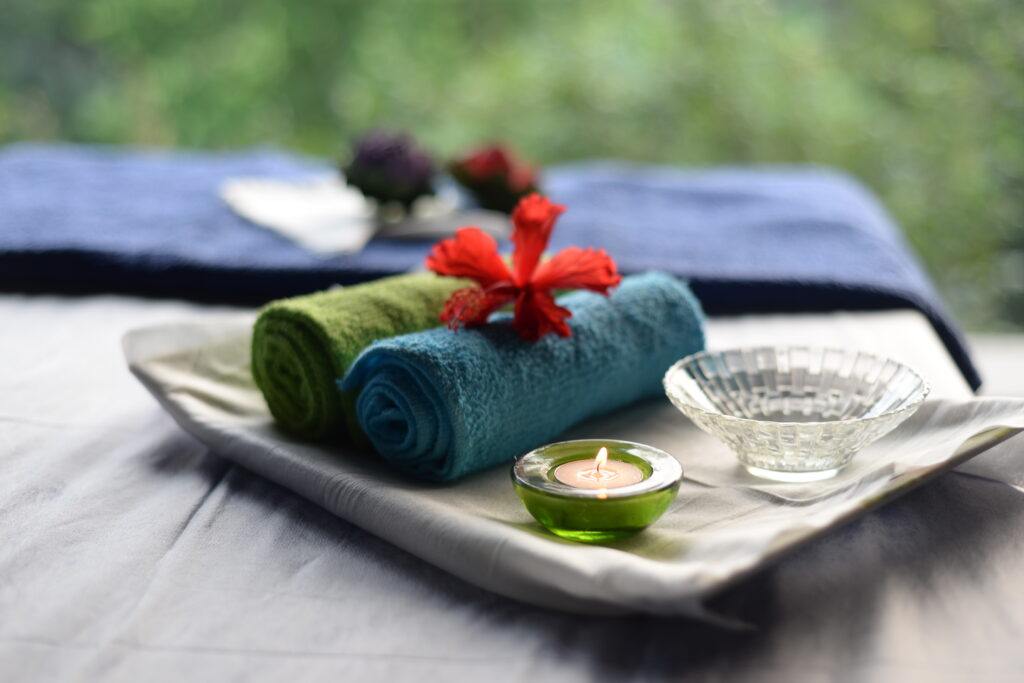
Dincharya & Ritucharya
The sanskrit word Dincharya means daily regimen.
It is important to follow a daily regime in order to be optimally healthy. Everyday two cycles of change pass through us, each bringing a Vata, Pitta, or Kapha predominance.
First cycle
6a.m. to 10a.m. Kapha
10a.m. to 2p.m. – Pitta
2 p.m. to 6 p.m. – Vata
Secondcycle
6 p.m. to 10 p.m. – Kapha
10 p.m. to 2 p.m. – Pitta
2 a.m to 6 p.m. – Vata
In Ayurveda the night is divided into 16 periods from sunset to sunrise. The ideal time to arise is during the 14th period which is about 2 hours before dawn, around 4:30.am to 5:00am. From 2 am until 6 am, the Vata element is dominant. (Vata is light, subtle and clear) It is advisable to wake up between 4:30.am to 5:00.am as not only due to increased Sattva in atmosphere but also due to decrease dust in air with 4 to 5% more of oxygen in air thereby giving more of Prana shakti and purity of thoughts and so a healthy body. Immediately after rising from bed one should check for nostril dominance for breathe. If right side nostril is dominant then one should put right leg on earth first and left leg for left nostril. This is followed by drinking a glass or two of warm water which helps in the elimination of accumulated toxins via urine. Brushing the teeth and scraping of tongue is done.
If indicated Abhyang (body massage with oil) is done and then shower is taken. Body is rubbed and pressed nicely while taking shower if prior massage is not taken. One should not use hot water for washing head and should start shower from head so that body heat moves in downwards direction. Bathing should be done in mild/lukewarm water, which is neither too hot nor too cold. Exercise and Meditation forms an important part of the morning activities along with Surya Namaskar (salutations to Sun God). In breakfast one should not start day with tea which otherwise reduces memory, concentration and also makes one more irritable.
Breakfast should be warm, nourishing and wholesome. If possible students should take very light breakfast otherwise their concentration is reduced. During noon lunch should be taken early between 12:15pm (do not eat during Sandhya) and 1:00p.m. this coincides with the peak Pitta period, Pitta is responsible for the digestion. Ayurveda recommends that the lunch should be the largest meal of the day. After the meal it is good to take a little walk, a couple hundred steps only, to help the food digest. Anything more than a short nap should be avoided because sleeping in the day is prohibited in Ayurveda.
Evening is the time between day and night a special time of balancing the whole day activity. This is the time for evening prayers and meditations in many cultures around the world. According to Ayurveda dinner should be taken around 7 p.m. It should not be heavy. It should be lighter than the lunch. The dinner should be made at least three hours before bedtime as gives the body ample time to digest the food and relax. Sleeping immediately after the dinner is not right. Walk to aid digestion for about 10 – 15 minutes. 10 p.m. is the bedtime. You should go to sleep around this time so that you get a sound sleep of six to seven hours. It is good to massage the soles of your feet before going to bed as it relaxes your system. This is the complete daily routine, which everyone should follow to lead a healthy lifestyle.
Ritucharya (Seasonal Regimen)
Each change of season brings shifts in wind conditions, temperature, and humidity or rainfall. As the predominance of the elements in the environment change, it will impact the balance of doshas within our bodies. If we recognise and respond to these environmental changes, we will better be able to maintain an ideal equilibrium of the doshas within our bodies.
An example of this might be the greater predominance of the fire element during summer. As heat grows in the environment, Pitta dosha will tend to increase within the body. When this particular functional capacity becomes too predominant, its relationship with the other two doshas becomes imbalanced, disrupting various physiological process. This then causes us to feel acidic, hot, physically uncomfortable and irritable. Ayurveda divides year into two kaals based on the position of sun.
Aadaankaal (Uttarayan) (Northernsolastice) and
Visarga kaal (Dakshinayaan) (Southern solastice).
Aadaan means taking away and visarga means giving. In aadaan kaal, the sun and wind are powerfull. The sun takes away the strength of the people and the cooling qualities of the earth. It is debilitating period, resulting in weakness. In visarga kall, the sun releases the strength to people. Moon is more powerfull, and earth becomes cooled due to clouds, rain, and cold wind. A year consists of 6 ritus (seasons). Each of this ritu is 2 masas (months) long. Three ritus (1 semister) form a kaal.
The Six Ritus
The six ritus and their properties can be summarized in the following table
| Kaal (semester) | Ritu (season) | Maas (month) | Properties of the season |
| Aadaan (Northeren solastice) | Sishira | Magha and phalguna (mid january to mid march) | Cold and dewy season |
| Vasanta | Chaitra and baisakh (mid march to mid may) | Spring season | |
| Grishma | Jyeshtha and aashadha (mid may to mid july) | Summer season | |
| Visarga (Southern solastice) | Varsha | Shravan and bhadrapada (mid july to mid september) | Rainy season |
| Sharat | Aashvin and kartika (mid september to mid november) | Autumn season | |
| Hemant | Margshirsha and pausha (mid november to mid january) | Winter season |